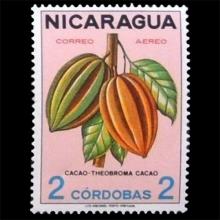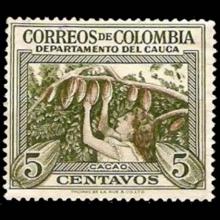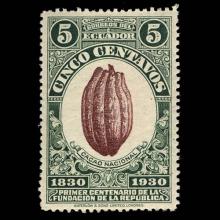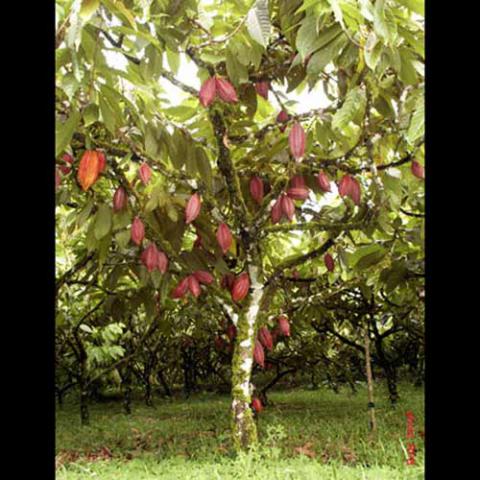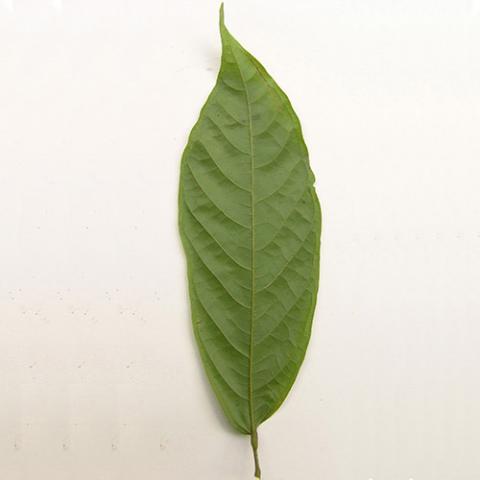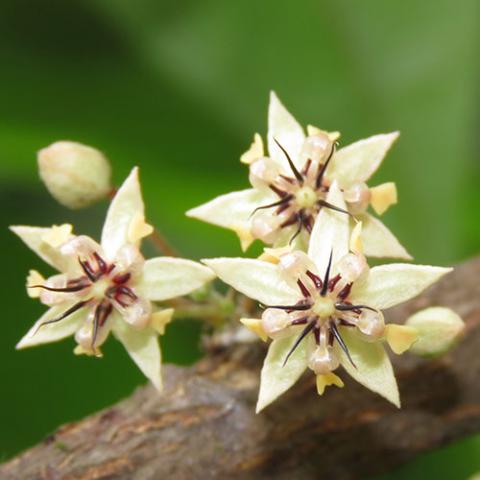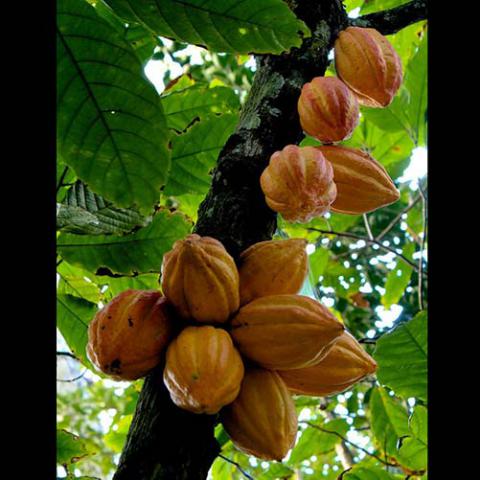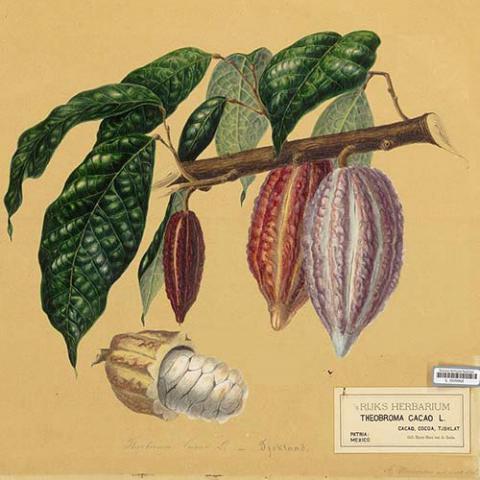NAME(S)
TAXONOMY
PLANTAE ID
THERAPEUTIC
Nicaragua
Issued:
Stamp:
Theobroma cacao
Colombia
Issued:
Stamp:
Theobroma cacao
Ecuador
Issued:
Stamp:
Theobroma cacao
Nicaragua
Issued:
Stamp:
Theobroma cacao
Colombia
Issued:
Stamp:
Theobroma cacao
Ecuador
Issued:
Stamp:
Theobroma cacao
Nicaragua
Issued:
Stamp:
Theobroma cacao
Colombia
Issued:
Stamp:
Theobroma cacao
Ecuador
Issued:
Stamp:
Theobroma cacao
Genus species (Plantae): Theobroma cacao
Theobroma cacao, also called the cacao tree and the cocoa tree, is a small (4–8 m (13–26 ft) tall) evergreen tree in the family Malvaceae, native to the deep tropical regions of Mesoamerica. Its seeds, cocoa beans, are used to make chocolate liquor, cocoa solids, cocoa butter and chocolate. The largest producer of cocoa beans in 2018 was Ivory Coast, with 37% of the world total.
Description
Leaves are alternate, entire, unlobed, 10–40 cm (3.9–15.7 in) long and 5–20 cm (2.0–7.9 in) broad.
The flowers are produced in clusters directly on the trunk and older branches; this is known as cauliflory. The flowers are small, 1–2 cm (0.39–0.79 in) diameter, with pink calyx. While many of the world's flowers are pollinated by bees (Hymenoptera) or butterflies/moths (Lepidoptera), cacao flowers are pollinated by tiny flies, Forcipomyia midges in the subfamily Forcipomyiinae. Using the natural pollinator Forcipomyia midges for Theobroma cacao was shown to have more fruit production than using artificial pollinators. The fruit, called a cacao pod, is ovoid, 15–30 cm (5.9–11.8 in) long and 8–10 cm (3.1–3.9 in) wide, ripening yellow to orange, and weighs about 500 g (1.1 lb) when ripe. The pod contains 20 to 60 seeds, usually called "beans", embedded in a white pulp. The seeds are the main ingredient of chocolate, while the pulp is used in some countries to prepare refreshing juice, smoothies, jelly, and cream. Usually discarded until practices changed in the 21st century, the fermented pulp may be distilled into an alcoholic beverage. Each seed contains a significant amount of fat (40–50%) as cocoa butter. The fruit's active constituent is the stimulant theobromine, a compound similar to caffeine.
Cultivation
In 2016, cocoa beans were cultivated on roughly 10,196,725 hectares (25,196,660 acres) worldwide. Cocoa beans are grown by large agroindustrial plantations and small producers, the bulk of production coming from millions of farmers with small plots. A tree begins to bear when it is four or five years old. A mature tree may have 6,000 flowers in a year, yet only about 20 pods. About 1,200 seeds (40 pods) are required to produce 1 kg (2.2 lb) of cocoa paste.
Historically, chocolate makers have recognized three main cultivar groups of cacao beans used to make cocoa and chocolate: Forastero, Criollo and Trinitario. The most prized, rare, and expensive is the Criollo group, the cocoa bean used by the Maya. Only 10% of chocolate is made from Criollo, which is arguably less bitter and more aromatic than any other bean. In November 2000, the cacao beans coming from Chuao were awarded an appellation of origin under the title Cacao de Chuao (from Spanish: 'cacao of Chuao').
The cacao bean in 80% of chocolate is made using beans of the Forastero group, the main and most ubiquitous variety being the Amenolado variety, while the Arriba variety (such as the Nacional variety) are less commonly found in Forastero produce. Forastero trees are significantly hardier and more disease-resistant than Criollo trees, resulting in cheaper cacao beans.
Major cocoa bean processors include Hershey's, Nestlé and Mars, all of which purchase cocoa beans via various sources. Chocolate can be made from T. cacao through a process of steps that involve harvesting, fermenting of T. cacao pulp, drying, harvesting, and then extraction. Roasting T. cacao by using superheated steam was found to be better than conventional roasting (use of ovens) because it resulted in same quality of cocoa beans in a shorter amount of time.
History of Cultivation
Cultivation, use, and cultural elaboration of cacao were early and extensive in Mesoamerica. Ceramic vessels with residues from the preparation of cacao beverages have been found at archaeological sites dating back to the Early Formative (1900–900 BC) period. For example, one such vessel found at an Olmec archaeological site on the Gulf Coast of Veracruz, Mexico dates cacao's preparation by pre-Olmec peoples as early as 1750 BC. On the Pacific coast of Chiapas, Mexico, a Mokaya archaeological site provides evidence of cacao beverages dating even earlier, to 1900 BC. The initial domestication was probably related to the making of a fermented, thus alcoholic, beverage. In 2018, researchers who analysed the genome of cultivated cacao trees concluded that the domesticated cacao trees all originated from a single domestication event that occurred about 3,600 years ago somewhere in Central America.
Several mixtures of cacao are described in ancient texts, for ceremonial or medicinal, as well as culinary, purposes. Some mixtures included maize, chili, vanilla (Vanilla planifolia), and honey. Archaeological evidence for use of cacao, while relatively sparse, has come from the recovery of whole cacao beans at Uaxactun, Guatemala and from the preservation of wood fragments of the cacao tree at Belize sites including Cuello and Pulltrouser Swamp. In addition, analysis of residues from ceramic vessels has found traces of theobromine and caffeine in early formative vessels from Puerto Escondido, Honduras (1100–900 BC) and in middle formative vessels from Colha, Belize (600–400 BC) using similar techniques to those used to extract chocolate residues from four classic period (around 400 AD) vessels from a tomb at the Maya archaeological site of Rio Azul. As cacao is the only known commodity from Mesoamerica containing both of these alkaloid compounds, it seems likely these vessels were used as containers for cacao drinks. In addition, cacao is named in a hieroglyphic text on one of the Rio Azul vessels. Cacao is also believed to have been ground by the Aztecs and mixed with tobacco for smoking purposes. Cocoa was being domesticated by the Mayo Chinchipe of the upper Amazon around 3,000 BC.
Modern history
The first European knowledge about chocolate came in the form of a beverage which was first introduced to the Spanish at their meeting with Moctezuma in the Aztec capital of Tenochtitlan in 1519. Cortés and others noted the vast quantities of this beverage the Aztec emperor consumed, and how it was carefully whipped by his attendants beforehand. Examples of cacao beans, along with other agricultural products, were brought back to Spain at that time, but it seems the beverage made from cacao was introduced to the Spanish court in 1544 by Kekchi Maya nobles brought from the New World to Spain by Dominican friars to meet Prince Philip. Within a century, chocolate had spread to France, England and elsewhere in Western Europe. Demand for this beverage led the French to establish cacao plantations in the Caribbean, while Spain subsequently developed their cacao plantations in their Venezuelan and Philippine colonies (Bloom 1998, Coe 1996). A painting by Dutch Golden Age artist Albert Eckhout shows a wild cacao tree in mid-seventeenth century Dutch Brazil. The Nahuatl-derived Spanish word cacao entered scientific nomenclature in 1753 after the Swedish naturalist Linnaeus published his taxonomic binomial system and coined the genus and species Theobroma cacao. Traditional pre-Hispanic beverages made with cacao are still consumed in Mesoamerica. These include the Oaxacan beverage known as tejate.
Mythology
The Maya believed the kakaw (cacao) was discovered by the gods in a mountain that also contained other delectable foods to be used by them. According to Maya mythology, the Plumed Serpent gave cacao to the Maya after humans were created from maize by divine grandmother goddess Xmucane. The Maya celebrated an annual festival in April to honor their cacao god, Ek Chuah, an event that included the sacrifice of a dog with cacao-colored markings, additional animal sacrifices, offerings of cacao, feathers and incense, and an exchange of gifts. In a similar creation story, the Mexica (Aztec) god Quetzalcoatl discovered cacao (cacahuatl: "bitter water"), in a mountain filled with other plant foods. Cacao was offered regularly to a pantheon of Mexica deities and the Madrid Codex depicts priests lancing their ear lobes (autosacrifice) and covering the cacao with blood as a suitable sacrifice to the gods. The cacao beverage was used as a ritual only by men, as it was believed to be an intoxicating food unsuitable for women and children.
Reference: Wikipedia
Photos: Rolando Pérez

